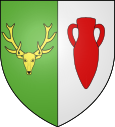Villeneuve-les-Cerfs
| Villeneuve-les-Cerfs | ||
|---|---|---|

|
|
|
| region | Auvergne-Rhône-Alpes | |
| Department | Puy-de-Dôme | |
| Arrondissement | Riom | |
| Canton | Maringues | |
| Community association | Plaine Limagne | |
| Coordinates | 46 ° 1 ′ N , 3 ° 20 ′ E | |
| height | 311-401 m | |
| surface | 9.89 km 2 | |
| Residents | 532 (January 1, 2017) | |
| Population density | 54 inhabitants / km 2 | |
| Post Code | 63310 | |
| INSEE code | 63459 | |
| Website | www.villeneuve-les-cerfs | |
Villeneuve-les-Cerfs is a French municipality with 532 inhabitants (as of January 1 2017) in the department of Puy-de-Dôme in the region Auvergne Rhône-Alpes (before 2016 Auvergne ). The municipality belongs to the arrondissement of Riom and the canton of Maringues (until 2015: canton of Randan ). Villeneuve-les-Cerfs is about 22 kilometers northeast of Riom . The river Buron runs along the southwestern boundary of the municipality .
history
In 1191 (or 1192) the abbot of the monastery of Saint-Alyre confirmed: "The municipality of Villeneuve was dependent on the church of Chassignoles". This is the earliest proven attribution of the community. The newly founded parish of Villeneuve les Cerfs is also mentioned in King Pépin's charter (beginning of the 12th century) in connection with the restoration of the Mozat monastery . Next, the parish is mentioned in connection with the Saint Bonnet church, which was destroyed there in the 18th century . The architect Imbert, who was commissioned to build the new church, suggested “using old materials made from demolition material, consisting of rubble, wood and stones from an old chapel [...] and stones from the cemetery”. The new church was built in 1844. In the Middle Ages, the parish came into the possession of the Abbey of Saint-Alyre de Clermont through donations and purchases , whose abbot appointed the parish priest of the church of Villeneuve-les-Cerfs until 1789. In 1788 there are 28 homeowners in the municipality. In connection with the French Revolution it is reported that in 1790 the pastor refused to take an oath on the (new) civil constitution. In the 19th century the township developed economically, no special events have been recorded.
After evaluating aerial photographs, archaeologists found remains of medieval buildings at a place called La croix des Rameaux , which are interpreted as brickworks. They also found the hamlet ( Hameau ) des Pioliers, in which ceramics were probably made in the 14th century.
Name declaration
The origin of cerf is not clear, there are the following theories: The name Villeneuve les Cerfs , used in the 13th century as Villa del Seirs , refers to the situation at that time ( Neustadt ) and to Seir (= serf ), which is in the orthography similar to the Serfs (= deer ) can be understood. Serfs is also interpreted as a misspelling of les Serves elsewhere , which could describe the numerous watermills that have been here.
Population development
For several centuries the population has been steadily below 1000, but fluctuates a little. The maximum was reached in 1806. A trend cannot be derived from this.
| year | 1800 | 1806 | 1901 | 1962 | 1975 | 1982 | 1990 | 1999 | 2006 | 2016 |
|---|---|---|---|---|---|---|---|---|---|---|
| Residents | 640 | 946 | 564 | 305 | 260 | 306 | 423 | 399 | 464 | 537 |
- Source: Cassini and INSEE
Traffic and transportation
The RD 210 road ( route départementale 210 ), which leads from Clermont-Ferrand and Thuret to Randan, crosses the municipality. Individual streets (RD 63, RD 223, RD 93, RD 435 and RD 4311) connect the various districts or small village locations with one another.
There are no railway lines and no connection to a regional bus line ( Transdôme network ). The nearest train stations with TER stops are in the towns of Aubiat and Gannat, each 13 kilometers away, and in the town of Vichy, just under 15 kilometers away .
Attractions
- Church, built in 1844 as a second building
- Town hall: In 2012 a new building was inaugurated, which cost 372,000 euros . There is now a much larger usable area (250 m²) compared to the former official building (45 m²).
- Pigeon houses : These eye-catching historical half-timbered buildings stand in different places in the village, even a street, the Rue des Pigeonniers ( Taubenhausstraße ) is named after them.
Web links
Individual evidence
- ↑ a b c d History of the community (French), accessed on February 27, 2019.
- ↑ Map of the municipality on www.geoportail.gouv.fr.
- ↑ Tout savoir sur Villeneuve-les-Cerfs at communes.com, accessed on May 27, 2019


